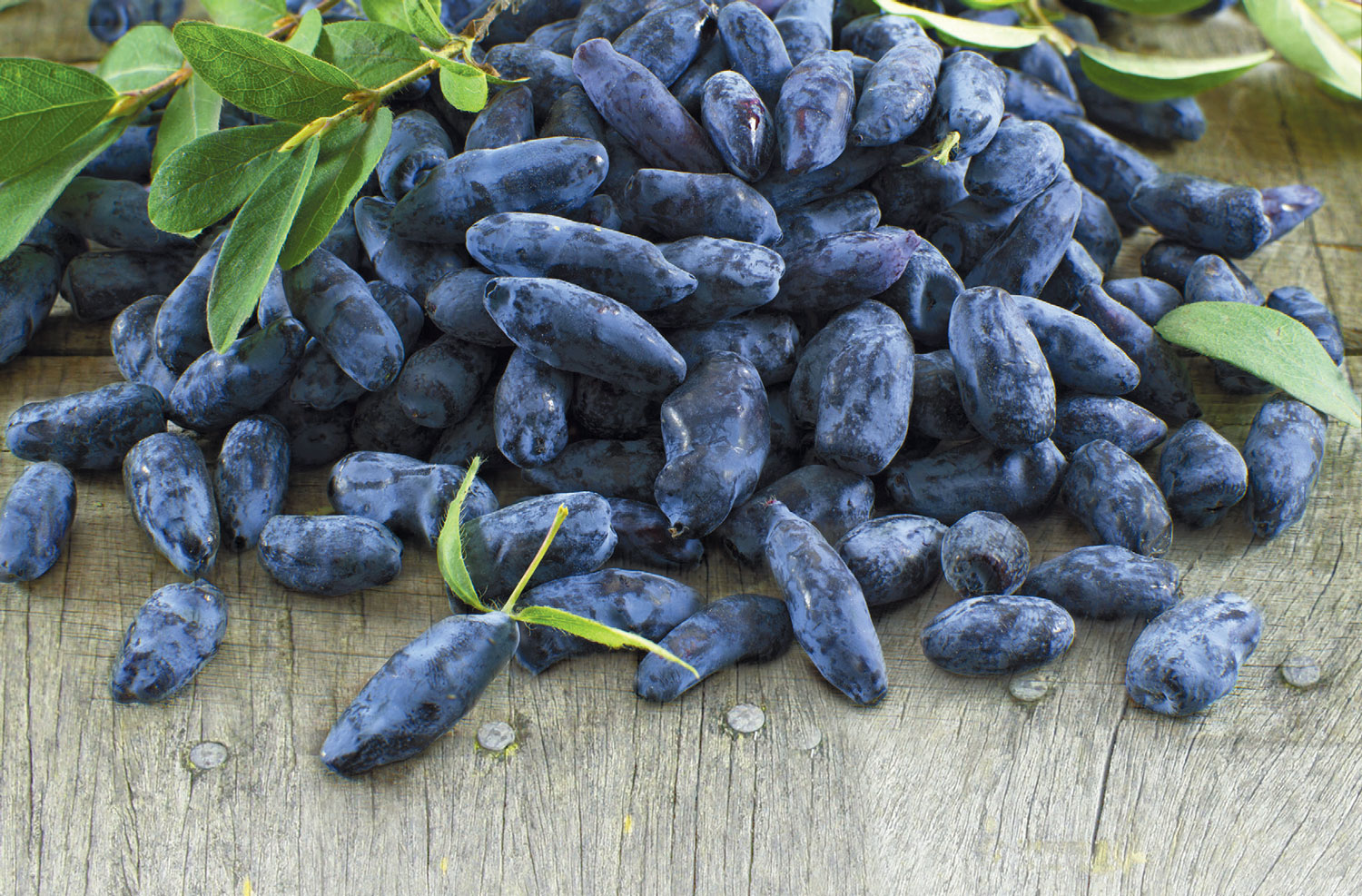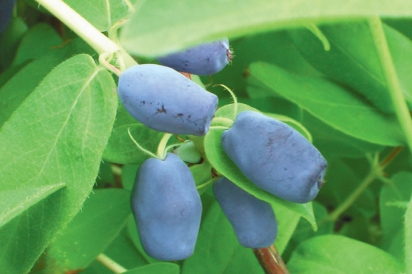Fruit of the Future: Transforming local agriculture with the haskap berry
Around the turn of the 19th century, an unfamiliar fruit appeared throughout New York and Pennsylvania. Some considered it ornamental, others believed it poisonous—still others called it the “love apple.”
Suffice it to say that no one who witnessed this fruit’s humble beginnings, amusingly recounted in Andrew F. Smith’s The Tomato in America: Early History, Culture, and Cookery, could have anticipated that the tomato would one day be named the world’s most popular fruit. (Yes, fruit.)
But this isn’t a story about tomatoes. It’s about another promising fruit that’s yet to catch on. No one’s calling it ornamental, no one’s calling it poisonous. In fact, no one’s calling it much at all, at least not in these parts. Yet. But if researchers in Northeast, PA, have their way, that just might change.
The name of this mysterious fruit? Haskap. (Unfortunately.) At best, it recalls ASCAP, the organization that lords over playlists at bars and restaurants. At worst, it sounds like HAZMAT—not a word ideally associated with something you’re going to eat. Perhaps Lonicera cerulea L. is catchier?
But to the indigenous Ainu people of Hokkaido, Japan, where the berry is native, haskap simply means “many fruits on branches.”
Delicious fruits, I might add. Often described as somewhere between a blueberry and a raspberry, they are succulent, juicy and bursting with flavor—with royally luscious color, to boot. Haskaps look like fetchingly elongated, supersaturated blueberries. It’s just a matter of time before their delectability, versatility and superior antioxidant content turn them into “many fruits in shopping carts,” as well.
In “Introducing Haskap, Japanese Blue Honeysuckle,” researcher Maxine M. Thompson explains that haskap berries were important to the hunter-gatherer Ainu, because they ripened early, when little other fruit was available, and also for health benefits. Haskaps were “treasured as ‘the elixir of life.’“
Haskaps remain popular in Japan, in myriad foods like candies, baked goods, juices, wine, yogurt, syrups and tea. And they’ve become increasingly sought after in Canada over the last decade or so, thanks largely to researchers at the University of Saskatchewan enthusiastically cross-breeding and perfecting them.
When the most prominent of these researchers, Bob Bors, presented at the Ontario Fruit and Vegetable Convention in Niagara Falls a few years ago, Jody Timer and Bryan Hed of Penn State University’s Lake Erie Regional Grape Research and Extension Center became intrigued.
They’d been exploring ways to diversify the 40-plus acres of grapes at the center in Northeast, and the dominance of Concords throughout the region.
“Haskaps ripen during a typical downtime for Concords, when growers are done with tying, but before their crop starts up,” notes Timer, “so they would be a nice complementary crop. They even grow well in the same type of soil as grapes, with similar pH requirements.”
They’re also fairly low-maintenance— easier to grow than blueberries, according to some accounts. And given their disease resistance, and the fact that they fruit before most pests emerge, they’re great candidates for organic growing. One of the biggest advantages of haskaps is their cold-hardiness. It’s no accident that they’re thriving in Saskatchewan, which only averages about 100 frost-free days per year.
In fact, “This is about as far south as you can grow them,” emphasizes Timer. “It’s one crop we can grow better here than in California.”
In the US, haskaps are also being grown in Oregon, Washington, Idaho, Michigan and Minnesota—where Honeyberry USA, a haskap nursery, is based. Some of the 50 plants at the research center are Honeyberry offspring, while others came from Canadian suppliers like La- Have Natural Farms/Haskapa.
In Nova Scotia, Haskapa sells haskap-based products, while promoting their nutritional benefits. The berries are widely reported as having up to three times the antioxidants as blueberries, more vitamin C than oranges, plus high levels of calcium, potassium, phosphorus and fiber. A quick internet search returns multiple headlines touting them as “the new superfood.”
In Nova Scotia, Haskapa reports that chefs are incorporating haskaps into various recipes, from cheesecake to seafood sauce. Additionally, a local distillery sold out the initial 100 bottles of Haskap Berry Liquor they’d brewed in three days.
Timer visited Haskapa’s shop in Nova Scotia last fall, sampling jams, skin cream and dried berries, which she says were just as tasty as dried cranberries (though we had to laugh, imagining what they might be called…Has-rins? Rais-kaps?). The well-crafted wine she tried was also quite good—smooth, tart enough not to be overly-sweet, and richly red in color.
In fact, she notes, just as many wineries add a darker grape variety to deepen their reds, some are exploring ways to use haskaps as food dye, thanks to the vivid color they impart.
Haskaps can start blooming as winter turns to spring. But unlike many fruit crops, their blooms are not harmed by frost or freezing temperatures. Timer adds that proximity to Lake Erie is ideal because it keeps the springs cooler, since damage can occur once the plants leaf out.
Haskaps do require netting to ward off hungry birds. Otherwise, they’re relatively problem-free, but Timer wishes she could spend more time determining ideal harvesting schedules, amendments and other factors that might really help haskaps take off locally. “Most of this research has come out of Saskatchewan,” she explains, “which is why it’s important to grow some down here and see [what works best].”
A lack of funding has limited research at the center. While a small amount from a Penn State account helped the project get off the ground (or in the ground) in 2014, it’s been unfunded ever since. Timer has put in a request to the Pennsylvania Horticultural Society every year, “and they haven’t funded it.”
But Timer remains optimistic. “I hope we get enough information to say to growers, ‘this is a good crop, this is how you grow it and these are the varieties that work here,’“ she explains. She also hopes that a major producer like Welch’s will pick them up as an alternative, thus propelling them beyond the specialty sphere.
Haskaps may never reach the tomato’s global stardom. But who knows? Maybe in a few years, the more horticulturally adventurous of us will be the envy of our neighborhoods, harvesting our backyard haskaps by strawberry season. Maybe in a decade, we’ll forget what we sipped before haskap smoothies became de rigueur. Maybe one day, a clever historian will pen a tome about haskaps’ humble beginnings, and how a fruit-growing region on the shores of Lake Erie was forward-thinking enough to capitalize on them.
> Want to plant haskaps? Visit HoneyberryUSA.com. Want to purchase haskap-based products? Visit Haskapa’s Amazon site. Want more information? Visit the University of Saskatchewan’s haskap site at fruit.usask.ca/haskap.html.
> Visitors are welcome to tour the haskap orchard at the Lake Erie Regional Grape Research and Extension Center, 662 N Cemetery Rd, North East, PA. Please call first: 814-725-4601






